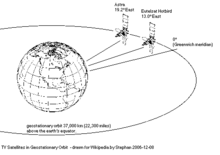Communications satellite


Communication satellites (also message or telecommunications satellites ) are unmanned artificial satellites that orbit the earth and enable information or data transmission in certain areas of the earth's surface. Their orbits are relatively high in order to be able to cover large areas.
The most common are geostationary satellites , which are used primarily for the transmission of television and radio programs ( see also television satellite ). Other applications are satellite communication , digital data transmission or large-scale telephone traffic . In addition to the satellites, which are mostly maintained by government and commercial carriers, there are also amateur radio satellites .
General
Some of the first experimental communications satellites worked passively, that is, they were large metalized balloons that were illuminated by powerful radio link transmitters and reflected radio waves. Later generations of communications satellites are actively working: transponders on board the satellite receive the signal from the ground station and send it back to a specific area of the ground via directional antennas. The geographical area in which the satellite signal can be received is called the coverage area . In communications satellites with weak transmission equipment, the signal is received again by earth stations and fed into the telecommunications network. The radio broadcasts are then either transmitted terrestrially or fed into the broadband cable network. Earth stations for cable television are called cable headends.
Modern communications satellites have transponders whose transmitters are so powerful that they can be received directly by the consumer. For a good signal quality there must be a quasi line of sight to the satellite. Signal attenuation by walls, houses or heavy rain makes reception difficult to the point of impossibility.
Some communications satellites have additional functions. You can e.g. B. Transmit correction signals for satellite navigation .
The communications satellites orbit the earth on circular or elliptical orbits. The most important type of communication satellites are satellites which orbit the earth in a geostationary orbit, i.e. always stand over the same place when viewed from the earth (synchronous satellite ). With three synchronous satellites each rotated by 120 °, every place on earth can be reached, except for the polar regions. For the polar regions, satellites are used on Molnija orbits with a high inclination to the equator .
history
The first communications satellite was SCORE and was launched on December 18, 1958 in the USA. It could pass messages on directly without delay or, when flying over a ground station, it recorded a message on tape and played it back over another ground station. However, SCORE only worked for 13 days.
The lack of a return channel, however, was not acceptable for normal communications (telephone etc.). In addition, the operating time was too short. Therefore, the first passive communications satellite Echo 1 was launched on August 12, 1960 . It was a balloon with a reflective metal surface. Echo 1 reflected the signals that one ground station sent to it on to another, while at the same time the latter could use it to reflect a signal to the first ground station on a different frequency.
However, when it was later realized that effective information transmission is only possible using active satellites, further investments had to be made in this technology. On July 10, 1962, the first television satellite, called Telstar , was finally launched into space. This has already enabled television transmission between Japan, the USA and Europe.
On February 14, 1963, Syncom 1 became the first communications satellite to be launched into geostationary orbit. However, since he refused his service, he was replaced by Syncom 2 on July 26, 1963 . It was the first so-called synchronous satellite for terrestrial telephone traffic and telecommunications.
The first commercially used geostationary communications satellite was Intelsat I , also known as the "Early Bird". It was launched into space on April 6, 1965 from Cape Kennedy .
Europe only began launching communications satellites around the mid-1970s. The first two were called Symphony 1 and Symphony 2 and were launched on December 19, 1974 and August 27, 1975, respectively. They emerged from a collaboration between France and Germany.
In 2009, with the launch of the Mars Telecommunications Orbiter , a communications satellite was to be sent on its way to another planet for the first time. There it was supposed to support the exploration of Mars by increasing the transmission capacity between the Mars probes and Earth . In July 2005, however, the mission was canceled by NASA for budget reasons.
See also
Web links
Individual evidence
- ↑ Score in the Encyclopedia Astronautica , accessed on September 21, 2012 (English).

